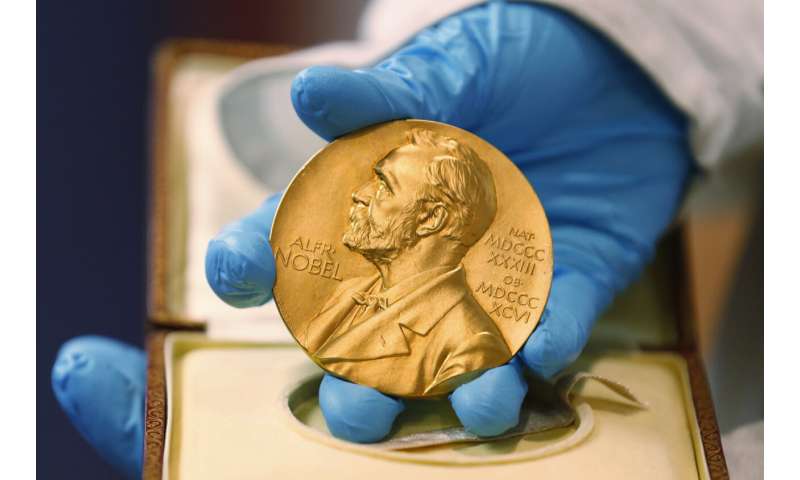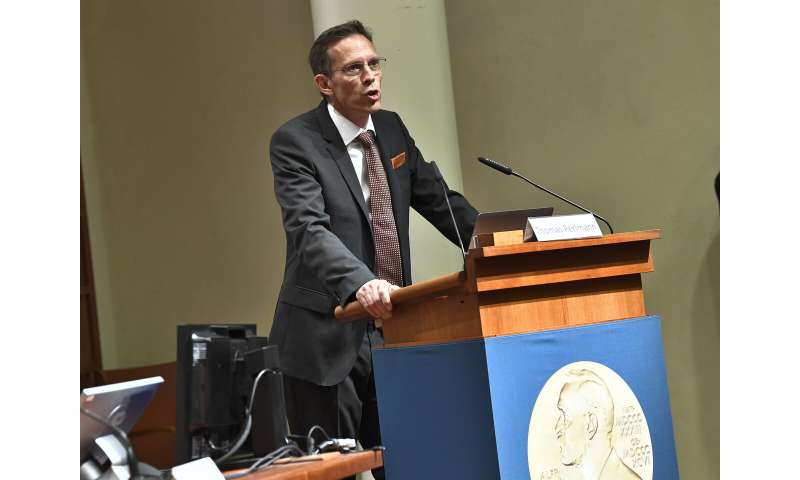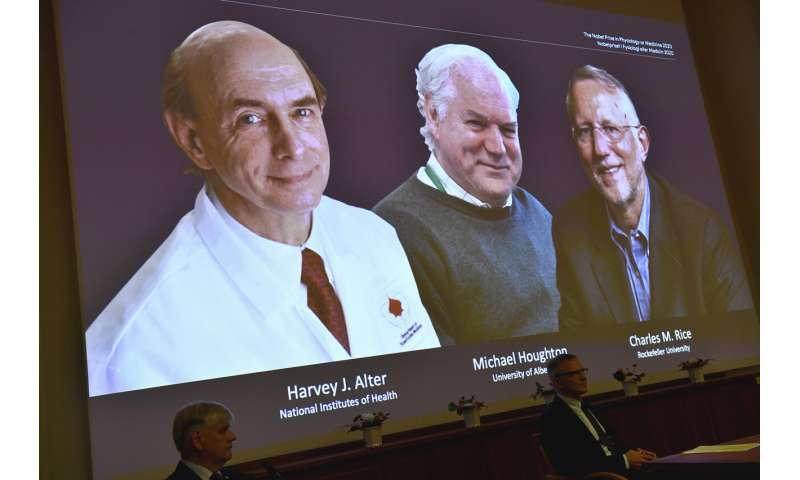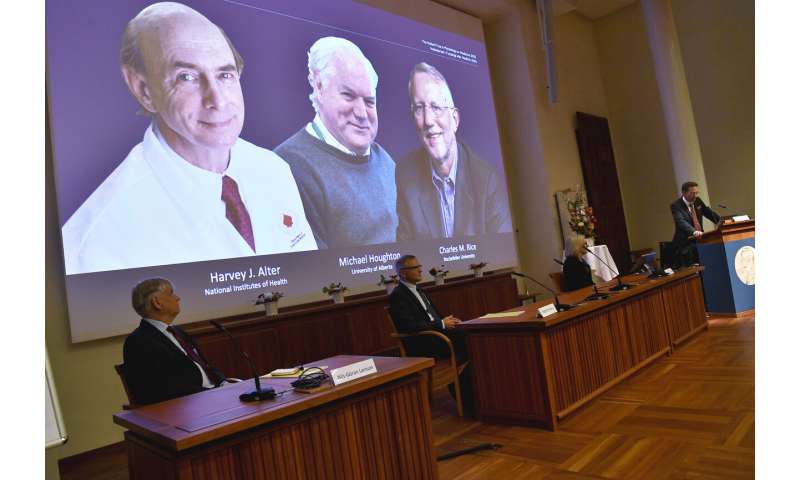
Americans Harvey J. Alter and Charles M. Rice, and British-born scientist Michael Houghton were awarded the Nobel Prize for Medicine or Physiology on Monday for the discovery of the hepatitis C virus, a major source of liver disease that affects millions worldwide.
Announcing the prize in Stockholm, the Nobel Committee noted that the trio’s work helped explain a major source of blood-borne hepatitis that couldn’t be explained by the previously discovered hepatitis A and B viruses. Their work, dating back to the 1970s and 1980s, has helped saved millions of lives, the committee said.
“Thanks to their discovery, highly sensitive blood tests for the virus are now available and these have essentially eliminated post-transfusion hepatitis in many parts of the world, greatly improving global health,” the committee said.
“Their discovery also allowed the rapid development of antiviral drugs directed at hepatitis C,” it added. “For the first time in history, the disease can now be cured, raising hopes of eradicating hepatitis C virus from the world population.”
The World Health Organization estimates there are over 70 million cases of hepatitis worldwide and 400,000 deaths each year. The disease is chronic and a major cause of liver inflammation and cancer.
The medicine prize carried particular significance this year due to the coronavirus pandemic, which has highlighted the importance that medical research has for societies and economies around the world.
Nobel Committee member Patrick Ernfors drew a parallel between this year’s prize and the current rush by millions of scientists around the world to combat the coronavirus pandemic.

“The first thing you need to do is to identify the causing virus,” he told reporters. “And once that has been done, that is in itself the starting point for development of drugs to treat the disease and also to develop vaccines against the disorder.”
“So the actual discovery, viral discovery itself is a critical moment,” said Enfors.
Alter was born in 1935 in New York and carried out his prize-winning studies at the U.S. National Institutes of Health in Bethesda, where he remains active, the commitee said.
Rice was born in 1952 in Sacramento, California. He worked on hepatitis at the Washington University in St. Louis and now works at Rockefeller University in New York.
Michael Houghton was born in Britain 1950 in the United Kingdom and did his studies at the Chiron Corporation in California before moving to the University of Alberta in Canada.


Thomas Perlmann, the Secretary-General of the Nobel Committee, said he managed to reach two of the winners, Alter and Rice.
“I had to call a couple of times before they answered,” he said. “They seemed very surprised and very, very happy.”
The prestigious Nobel award comes with a gold medal and prize money of 10 million Swedish kronor (over $1,118,000), courtesy of a bequest left 124 years ago by the prize’s creator, Swedish inventor Alfred Nobel.
The Nobel Committee often recognizes basic science that has laid the foundations for practical applications in common use today.
Monday’s mdecine award is the first of six prizes being announced through Oct. 12. The other prizes are for outstanding work in the fields of physics, chemistry, literature, peace and economics.
https://youtube.com/watch?v=BTu6uOWLKR4%3Fcolor%3Dwhite
The Nobel Foundation announcement:
The Nobel Assembly at Karolinska Institutet
has today decided to award
the 2020 Nobel Prize in Physiology or Medicine
jointly to
Harvey J. Alter, Michael Houghton and Charles M. Rice
for the discovery of Hepatitis C virus
SUMMARY
This year’s Nobel Prize is awarded to three scientists who have made a decisive contribution to the fight against blood-borne hepatitis, a major global health problem that causes cirrhosis and liver cancer in people around the world.
Harvey J. Alter, Michael Houghton and Charles M. Rice made seminal discoveries that led to the identification of a novel virus, Hepatitis C virus. Prior to their work, the discovery of the Hepatitis A and B viruses had been critical steps forward, but the majority of blood-borne hepatitis cases remained unexplained. The discovery of Hepatitis C virus revealed the cause of the remaining cases of chronic hepatitis and made possible blood tests and new medicines that have saved millions of lives.
Hepatitis – a global threat to human health
Liver inflammation, or hepatitis, a combination of the Greek words for liver and inflammation, is mainly caused by viral infections, although alcohol abuse, environmental toxins and autoimmune disease are also important causes. In the 1940’s, it became clear that there are two main types of infectious hepatitis. The first, named hepatitis A, is transmitted by polluted water or food and generally has little long-term impact on the patient. The second type is transmitted through blood and bodily fluids and represents a much more serious threat since it can lead to a chronic condition, with the development of cirrhosis and liver cancer. This form of hepatitis is insidious, as otherwise healthy individuals can be silently infected for many years before serious complications arise. Blood-borne hepatitis is associated with significant morbidity and mortality, and causes more than a million deaths per year world-wide, thus making it a global health concern on a scale comparable to HIV-infection and tuberculosis.
An unknown infectious agent
The key to successful intervention against infectious diseases is to identify the causative agent. In the 1960’s, Baruch Blumberg determined that one form of blood-borne hepatitis was caused by a virus that became known as Hepatitis B virus, and the discovery led to the development of diagnostic tests and an effective vaccine. Blumberg was awarded the Nobel Prize in Physiology or Medicine in 1976 for this discovery.
At that time, Harvey J. Alter at the US National Institutes of Health was studying the occurrence of hepatitis in patients who had received blood transfusions. Although blood tests for the newly-discovered Hepatitis B virus reduced the number of cases of transfusion-related hepatitis, Alter and colleagues worryingly demonstrated that a large number of cases remained. Tests for Hepatitis A virus infection were also developed around this time, and it became clear that Hepatitis A was not the cause of these unexplained cases.
It was a great source of concern that a significant number of those receiving blood transfusions developed chronic hepatitis due to an unknown infectious agent. Alter and his colleagues showed that blood from these hepatitis patients could transmit the disease to chimpanzees, the only susceptible host besides humans. Subsequent studies also demonstrated that the unknown infectious agent had the characteristics of a virus. Alter’s methodical investigations had in this way defined a new, distinct form of chronic viral hepatitis. The mysterious illness became known as “non-A, non-B” hepatitis.
Identification of Hepatitis C virus
Identification of the novel virus was now a high priority. All the traditional techniques for virus hunting were put to use but, in spite of this, the virus eluded isolation for over a decade. Michael Houghton, working for the pharmaceutical firm Chiron, undertook the arduous work needed to isolate the genetic sequence of the virus. Houghton and his co-workers created a collection of DNA fragments from nucleic acids found in the blood of an infected chimpanzee. The majority of these fragments came from the genome of the chimpanzee itself, but the researchers predicted that some would be derived from the unknown virus. On the assumption that antibodies against the virus would be present in blood taken from hepatitis patients, the investigators used patient sera to identify cloned viral DNA fragments encoding viral proteins. Following a comprehensive search, one positive clone was found. Further work showed that this clone was derived from a novel RNA virus belonging to the Flavivirus family and it was named Hepatitis C virus. The presence of antibodies in chronic hepatitis patients strongly implicated this virus as the missing agent.
The discovery of Hepatitis C virus was decisive; but one essential piece of the puzzle was missing: could the virus alone cause hepatitis? To answer this question the scientists had to investigate if the cloned virus was able to replicate and cause disease. Charles M. Rice, a researcher at Washington University in St. Louis, along with other groups working with RNA viruses, noted a previously uncharacterized region in the end of the Hepatitis C virus genome that they suspected could be important for virus replication. Rice also observed genetic variations in isolated virus samples and hypothesized that some of them might hinder virus replication. Through genetic engineering, Rice generated an RNA variant of Hepatitis C virus that included the newly defined region of the viral genome and was devoid of the inactivating genetic variations. When this RNA was injected into the liver of chimpanzees, virus was detected in the blood and pathological changes resembling those seen in humans with the chronic disease were observed. This was the final proof that Hepatitis C virus alone could cause the unexplained cases of transfusion-mediated hepatitis.
Significance of this Nobel Prize-awarded discovery
The Nobel Laureates’ discovery of Hepatitis C virus is a landmark achievement in the ongoing battle against viral diseases. Thanks to their discovery, highly sensitive blood tests for the virus are now available and these have essentially eliminated post-transfusion hepatitis in many parts of the world, greatly improving global health. Their discovery also allowed the rapid development of antiviral drugs directed at hepatitis C. For the first time in history, the disease can now be cured, raising hopes of eradicating Hepatitis C virus from the world population. To achieve this goal, international efforts facilitating blood testing and making antiviral drugs available across the globe will be required.
Key publications:
Alter HJ, Holland PV, Purcell RH, Lander JJ, Feinstone SM, Morrow AG, Schmidt PJ. Posttransfusion hepatitis after exclusion of commercial and hepatitis-B antigen-positive donors. Ann Intern Med. 1972; 77:691-699.
Feinstone SM, Kapikian AZ, Purcell RH, Alter HJ, Holland PV. Transfusion-associated hepatitis not due to viral hepatitis type A or B. N Engl J Med. 1975; 292:767-770.
Alter HJ, Holland PV, Morrow AG, Purcell RH, Feinstone SM, Moritsugu Y. Clinical and serological analysis of transfusion-associated hepatitis. Lancet. 1975; 2:838-841.
Alter HJ, Purcell RH, Holland PV, Popper H. Transmissible agent in non-A, non-B hepatitis. Lancet. 1978; 1:459-463.
Choo QL, Kuo G, Weiner AJ, Overby LR, Bradley DW, Houghton M. Isolation of a cDNA clone derived from a blood-borne non-A, non-B viral hepatitis genome. Science. 1989; 244:359-362.
Kuo G., Choo QL, Alter HJ, Gitnick GL, Redeker AG, Purcell RH, Miyamura T, Dienstag JL, Alter CE, Stevens CE, Tegtmeier GE, Bonino F, Colombo M, Lee WS, Kuo C., Berger K, Shuster JR, Overby LR, Bradley DW, Houghton M. An assay for circulating antibodies to a major etiologic virus of human non-A, non-B hepatitis. Science. 1989; 244:362-364.
Kolykhalov AA, Agapov EV, Blight KJ, Mihalik K, Feinstone SM, Rice CM. Transmission of hepatitis C by intrahepatic inoculation with transcribed RNA. Science. 1997; 277:570-574.
Recent winners of the Nobel Medicine Prize
Here is a list of the winners of the Nobel Medicine Prize in the past 10 years following the announcement of the 2020 award on Monday:
2020: Americans Harvey Alter and Charles Rice, together with Briton Michael Houghton, for the discovery of the Hepatitis C virus, leading to the development of sensitive blood tests and antiviral drugs.
2019: William Kaelin and Gregg Semenza of the US and Britain’s Peter Ratcliffe for establishing the basis of our understanding of how cells react and adapt to different oxygen levels.
2018: Immunologists James Allison of the US and Tasuku Honjo of Japan, for figuring out how to release the immune system’s brakes to allow it to attack cancer cells more efficiently.
2017: US geneticists Jeffrey Hall, Michael Rosbash and Michael Young for their discoveries on the internal biological clock that governs the wake-sleep cycles of most living things.
2016: Yoshinori Ohsumi (Japan) for his work on autophagy—a process whereby cells “eat themselves”—which when disrupted can cause Parkinson’s and diabetes.
2015: William Campbell (US citizen born in Ireland) and Satoshi Omura (Japan), Tu Youyou (China) for unlocking treatments for malaria and roundworm.
2014: John O’Keefe (Britain, US), Edvard I. Moser and May-Britt Moser (Norway) for discovering how the brain navigates with an “inner GPS”.
2013: Thomas C. Suedhof (US citizen born in Germany), James E. Rothman and Randy W. Schekman (US) for work on how the cell organises its transport system.
2012: Shinya Yamanaka (Japan) and John B. Gurdon (Britain) for discoveries showing how adult cells can be transformed back into stem cells.
Source: Read Full Article